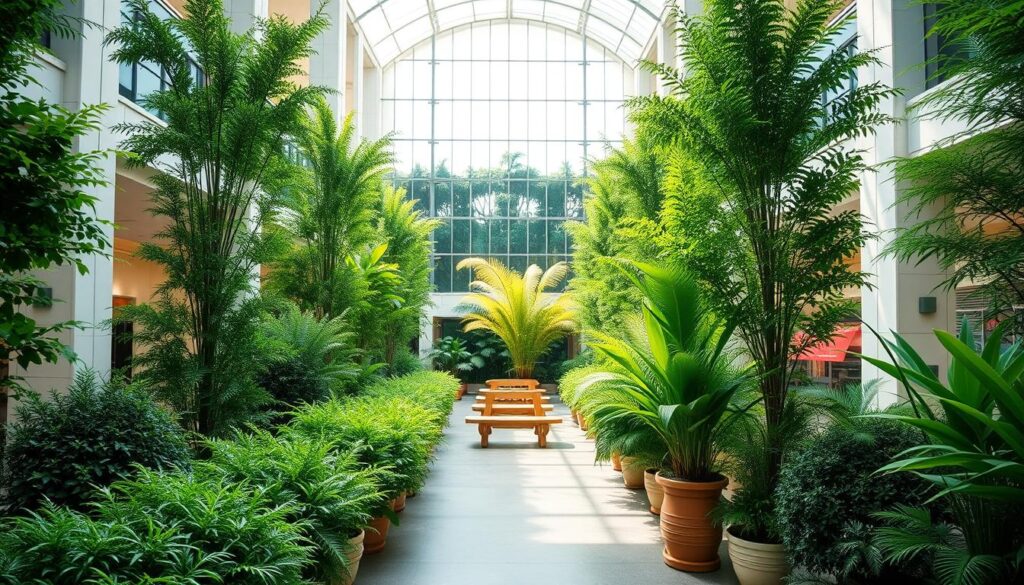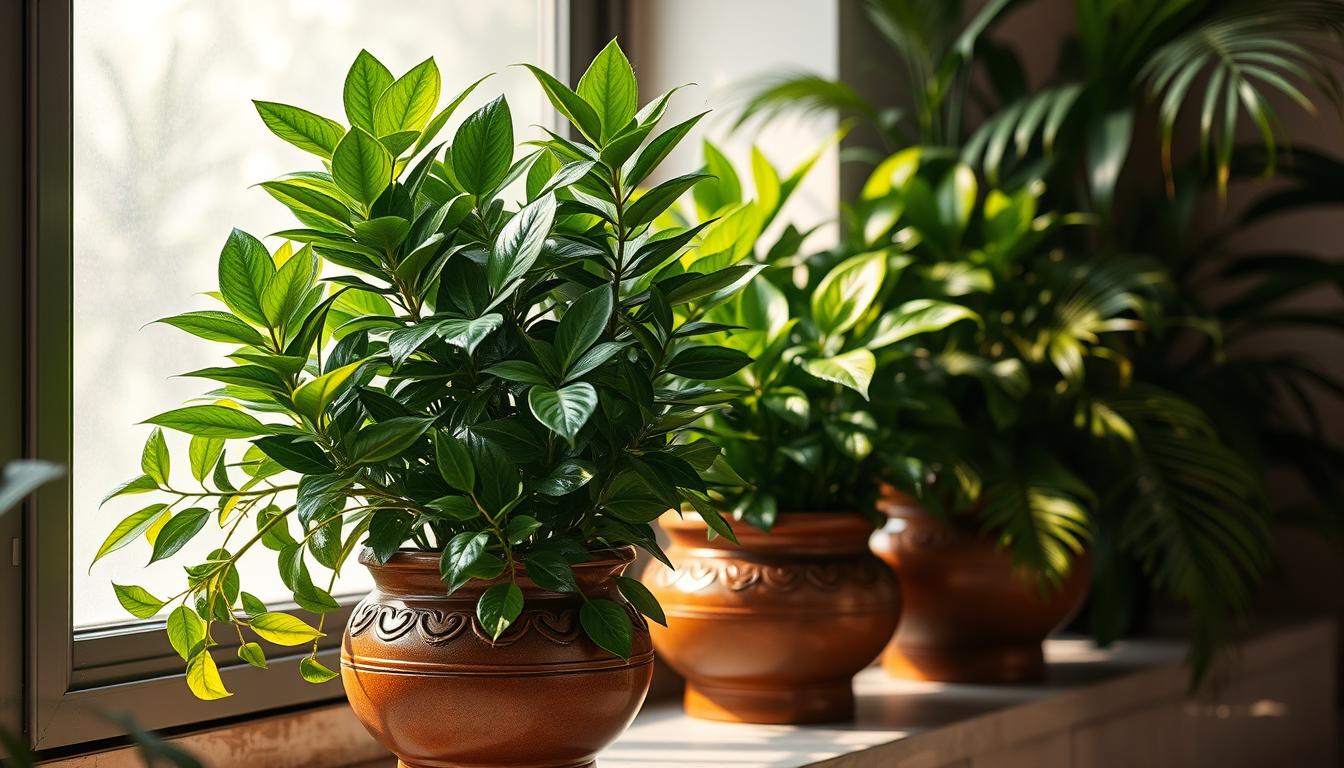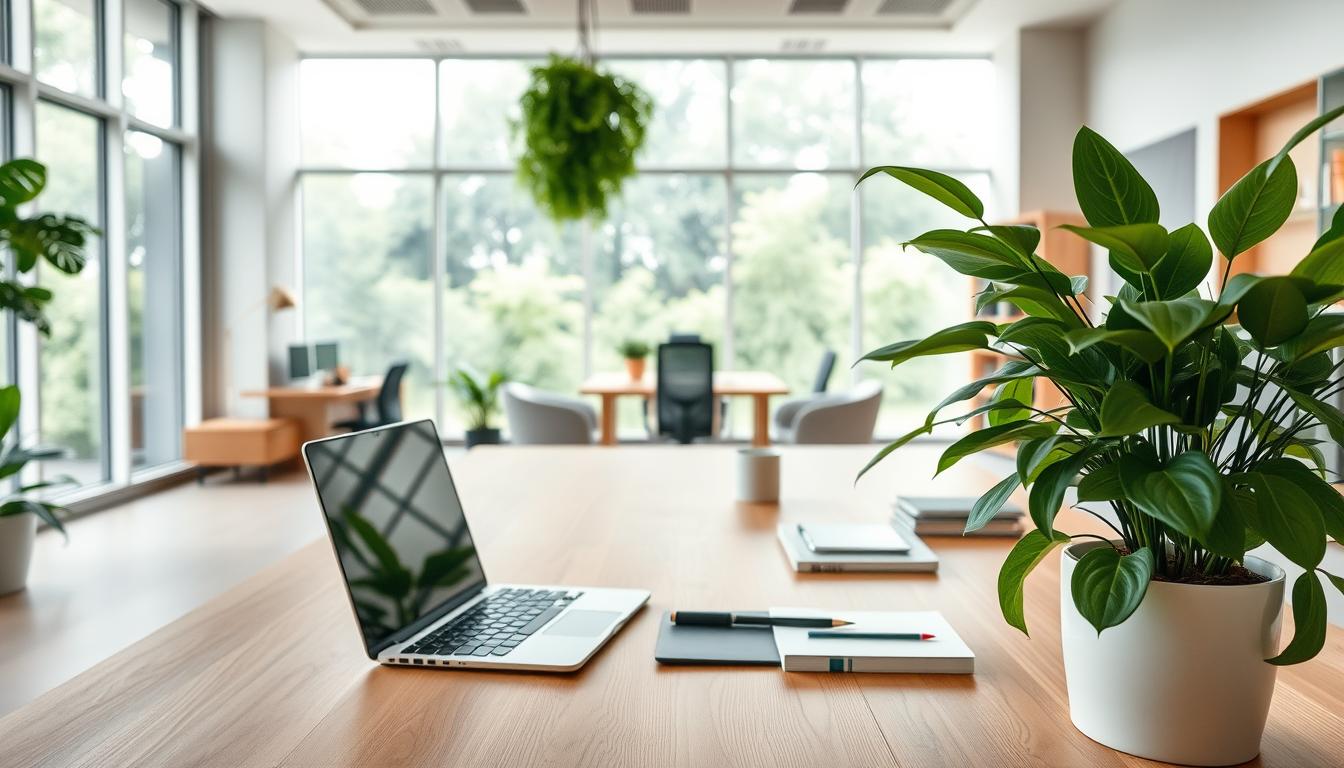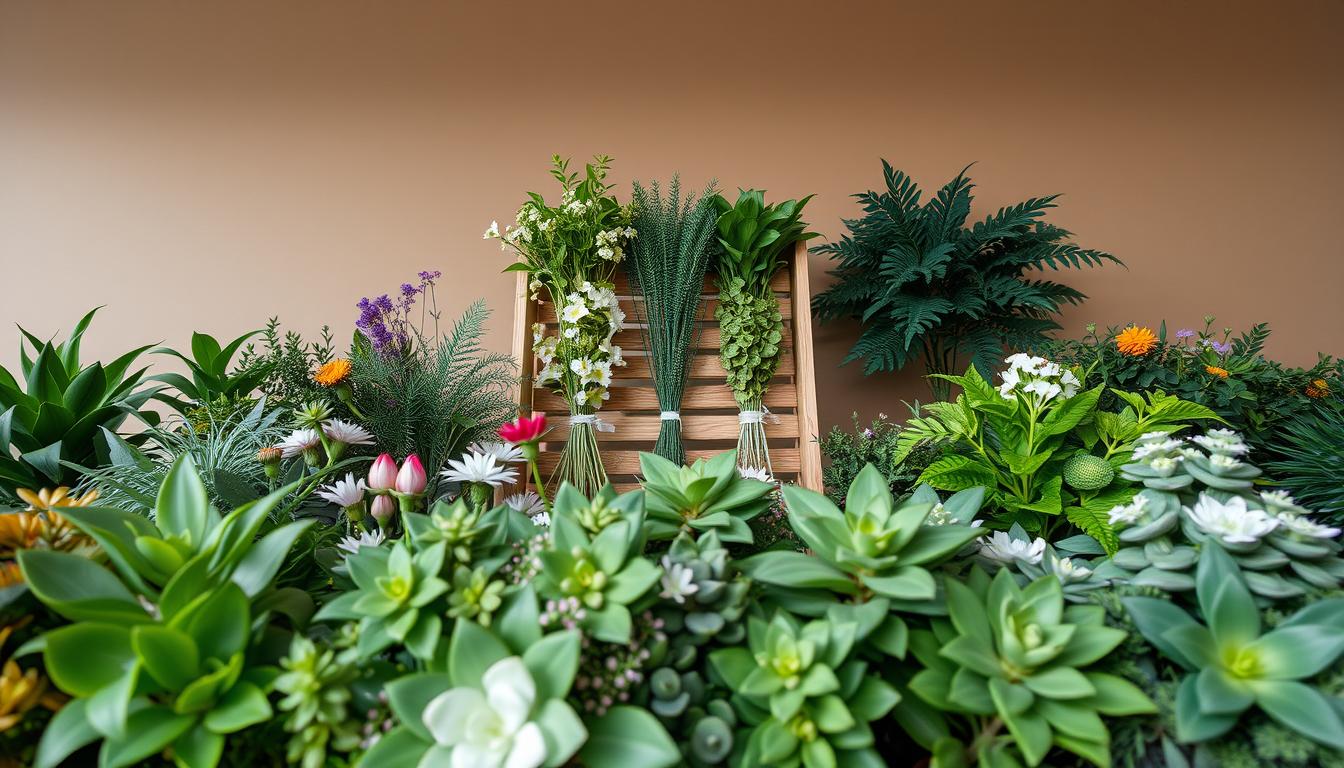Artificial greenery can make public spaces look great all year. But, it’s crucial to sanitize artificial plants regularly. This keeps them looking good and helps keep the community healthy and safe. Our guide will show you the importance of public greenery cleaning. It will also offer tips for artificial foliage maintenance.
Keeping artificial plants clean is important. It improves the appearance of public places and protects visitors from allergens and germs.
Introduction to Artificial Greenery in Public Areas
Artificial greenery is becoming vital for decorating public spaces. It brings nature’s beauty into cities. Places like parks, shopping centers, and office buildings use it to make areas more welcoming. These plants stay bright and green all year, without losing their charm. This means less worry about upkeep and keeping things eco-friendly. So, artificial plants are a great pick for public places.
Artificial greenery is not just about looks. It also has practical perks. These plants help with the design of the landscape, fitting right in. Public areas can look vibrant all the time by using faux plants. No need to stress over dying plants or seasonal changes. Knowing the benefits of artificial greenery can make us value its importance in cities more.

Importance of Sanitizing Artificial Greenery
Sanitizing artificial greenery boosts both looks and health in public areas. A tidy place not only looks good but is also safer. Regular cleaning helps make public spaces better and more enjoyable.
Enhancing Aesthetic Appeal
Keeping artificial plants clean is key to making them look good. Without cleaning, they can get dusty and lose their shine. Clean plants keep their beauty and make any area look better.
How a place looks can affect what people think of it. Clean, maintained greenery makes a great impression.
Health Considerations for Public Spaces
Ignoring cleanliness in public places affects more than just how things look. Dirt and allergens on artificial plants can harm visitors and workers. In busy spots like schools and malls, clean plants are important for health.
Dirty plants might grow mold, which is bad for everyone. Cleaning them well makes places safer and nicer for everyone.
How to Sanitize Artificial Greenery in Public Spaces
Keeping artificial greenery clean in public spots is very important. It keeps them looking good and germ-free. By cleaning them properly, they stay bright and safe from harmful stuff. Here’s a clear way to clean them and what you need to do it.
Step-by-Step Cleaning Process
- Start by dusting off loose debris outdoors using a soft-bristle brush. This initial step prepares the surface for deeper cleaning.
- If the artificial plants are water-safe, give them a gentle rinse to remove any remaining dirt and grime.
- Finally, dry the plants with a microfiber cloth to prevent moisture buildup, which can lead to mold growth.
This cleaning method is great for taking care of artificial plants. It makes sure they are not ruined while being cleaned.
Tools and Materials Needed
- Soft-bristle brushes for gentle dusting
- Microfiber cloths for drying
- Gentle dish soap for washing
- White vinegar solutions for eco-friendly cleaning
These tools are key for keeping artificial greenery in top shape. Choosing green cleaning options helps keep plant care sustainable. Each tool has a special role that ensures a deep clean without harming the plants.
Common Contaminants Found on Artificial Plants
Artificial greenery adds beauty to public places but can attract many contaminants over time. Dust and allergens gather, which could harm the health of people around. Keeping these plants clean is key to avoiding these risks and keeping the area nice and tidy.
Dust and Allergens
Dust and allergens on artificial plants can bother people, especially indoors. Things like pollen, animal fur, and mold particles are common allergens. Cleaning them well and often helps make the air healthier for everyone.
- Dust particles often settle on leaves, leading to dampness in public decor.
- These allergens can trigger reactions, affecting guests and staff alike.
- Proactive cleaning strategies minimize the accumulation of bacteria on greenery.
Potential Mold Growth
If artificial plants aren’t kept up, they can get moist and moldy. This mold can be bad for health because of the allergens in the air. Knowing what causes mold helps in stopping it from growing.
- Humidity levels can encourage mold formation on artificial greenery.
- Regular inspections help detect early signs of mold, facilitating timely intervention.
- Implementing effective sanitization methods is crucial for mold removal.
Best Practices for Routine Maintenance
For artificial plants in public areas, a good maintenance plan is key. This keeps them looking good and clean over time.
Here are some top tips for keeping artificial plants in tip-top shape:
- Dusting should occur at least once a week to prevent accumulation and maintain a fresh look.
- Use only gentle cleaning products specifically designed for synthetic materials to avoid damage.
- Rotate the placement of artificial plants periodically to minimize fading from sunlight exposure.
Following these tips can make managing your space easier and keep it looking nice.
Seasonal Deep Cleaning Tips
Keeping artificial greenery vibrant is key as spring nears. It’s time for deep cleaning to make these decorations look new. This includes checking for damage, cleaning well, and rearranging plants in public areas. Good deep cleaning tips can give them a fresh look for the warmer seasons.
Spring Cleaning for Artificial Greenery
Begin spring cleaning by gathering all needed tools and supplies. Regular dusting of artificial plants gets rid of built-up dirt. Use a wet cloth to remove tough dirt.
For a detailed clean, do the following:
- Take each plant out of its spot.
- Look for any damage like faded colors or broken leaves.
- Clean the plants with mild soap and water mixture.
- Let the plants dry completely before putting them back.
This spring care helps artificial plants last longer and stay beautiful.
Preparing for Summer Outdoor Use
As summer gets close, caring for outdoor plants is crucial. Make sure artificial plants can handle outdoor conditions, including UV rays. Here are tips for summer prep:
- Place plants where they won’t get too much sun.
- Use UV protective spray to keep colors bright.
- Clean plants often to keep them looking good and prevent color loss.
These steps help your artificial greenery look great outdoors during summer.
Choosing the Right Cleaning Solutions
Finding the best cleaners for artificial greenery is key. Using eco-friendly options helps keep spaces clean and supports the environment. White vinegar and baking soda are top picks. They clean without hurting the planet.
Eco-Friendly Options
Now, many places prefer cleaning that’s good for the earth. Here’s what works well for artificial plants:
- White vinegar mixed with water: This combo fights dust and keeps things smelling fresh.
- Baking soda: It’s great for keeping areas smelling nice.
- Essential oils: A little bit adds a nice scent and fights bacteria.
Making your own cleaners is budget-friendly and eco-smart. It’s great for places everyone uses.
Commercial Cleaning Products
Some folks like products ready to go. There are many safe and efficient options for fake plants. Check out these well-liked brands:
- FloraCraft®: Their products help artificial plants last longer.
- Artificial Plants Green Cleaner: It’s safe and keeps fake plants looking their best.
- Silk Plant Cleaner: This spray is easy to use and safe for silk plants.
Picking the right commercial cleaners makes upkeep easier. Plus, it keeps things green and clean.
Techniques for Specific Types of Artificial Plants
Caring for artificial plants means using the right cleaning methods for their materials. Looking after silk flowers and plastic plants the right way makes them last longer. They look better and brighten up spaces too.
Cleaning Silk Flowers
Silk flowers are delicate, so they need to be handled carefully when cleaned. Cleaning them the wrong way can harm their look. Some safe cleaning methods are suggested.
- Gentle Rinsing: Use lukewarm water to lightly rinse silk flowers, avoiding strong pressure that might dislodge petals.
- Vinegar Solutions: Mix equal parts vinegar and water to safely remove dust while maintaining the integrity of the material.
- Silk Flower Cleaners: Utilize specialized cleaners designed for delicate fabrics, ensuring effective sanitization without harsh chemicals.
Care for Plastic Greenery
Plastic plants can handle more direct cleaning techniques. Here are some tough yet safe cleaning tips for plastic plants:
- Rinsing with Water: Simply rinsing with warm water removes most contaminants without damaging the material.
- Mild Detergents: Employ gentle soaps or detergents, ensuring they are safe for plastics to enhance surface cleanliness.
- Regular Wiping: Use a damp cloth to wipe the leaves periodically, assisting in the upkeep of artificial greenery care.
Integrating Sanitization into Maintenance Schedules
Keeping artificial plants clean is part of proper facility maintenance. By setting up complete cleaning plans, organizations make sure cleaning is a regular activity. This kind of attention not only makes public areas look better but also keeps them safe and healthy.
To have efficient upkeep, try these methods:
- Incorporate artificial plants upkeep into daily cleaning tasks.
- Assign specific days for detailed sanitization processes, ensuring a regular refresh.
- Train staff to recognize when additional cleaning is necessary, particularly during peak seasons.
- Utilize checklists to monitor the condition and cleanliness of artificial plants regularly.
When you tie these actions to a bigger cleaning plan, it helps workers keep a smooth process. Reminding them often about cleaning well helps create a culture of neatness. This culture makes the fake plants last longer and look more inviting in public places.
Common Mistakes to Avoid When Sanitizing
Cleaning artificial plants needs careful attention. To keep their beauty and last long, you must avoid common cleaning mistakes. Knowing what products and methods to use can really improve how you take care of artificial plants.
- Using harsh chemicals can damage delicate materials. Always opt for milder solutions to ensure the integrity of the plants.
- Neglecting to check product labels for water resistance can lead to unexpected damage. Some artificial plants may not withstand exposure to water.
- Over-soaking silk plants during cleaning can cause them to become misshapen. Instead, dampen cloths and lightly wipe the surfaces to avoid mistakes.
- Forgetting to clean the storage area where artificial plants are kept can introduce contaminants. Regular upkeep of surrounding spaces supports better overall cleanliness.
By knowing these mistakes, you can clean your artificial plants the right way. This way, your plant care routines won’t be messed up.
Conclusion
Maintaining artificial greenery is key for keeping public places beautiful and safe. The cleaning tips shared in this article are not just for looks. They also keep allergens and mold at bay. By cleaning thoroughly, fake plants will keep looking good and be safe for everyone.
Facility managers and their teams are important in keeping our public areas nice. They use the cleaning methods we talked about. This makes places look better and helps everyone stay healthy. By keeping up with cleaning, artificial plants can stay fresh in parks, malls, and other spots.
Remember these cleaning tips when taking care of artificial greenery. Staying on top of cleaning has many benefits. It makes public places nicer for visitors and protects people’s health. This is crucial in places many people share.



